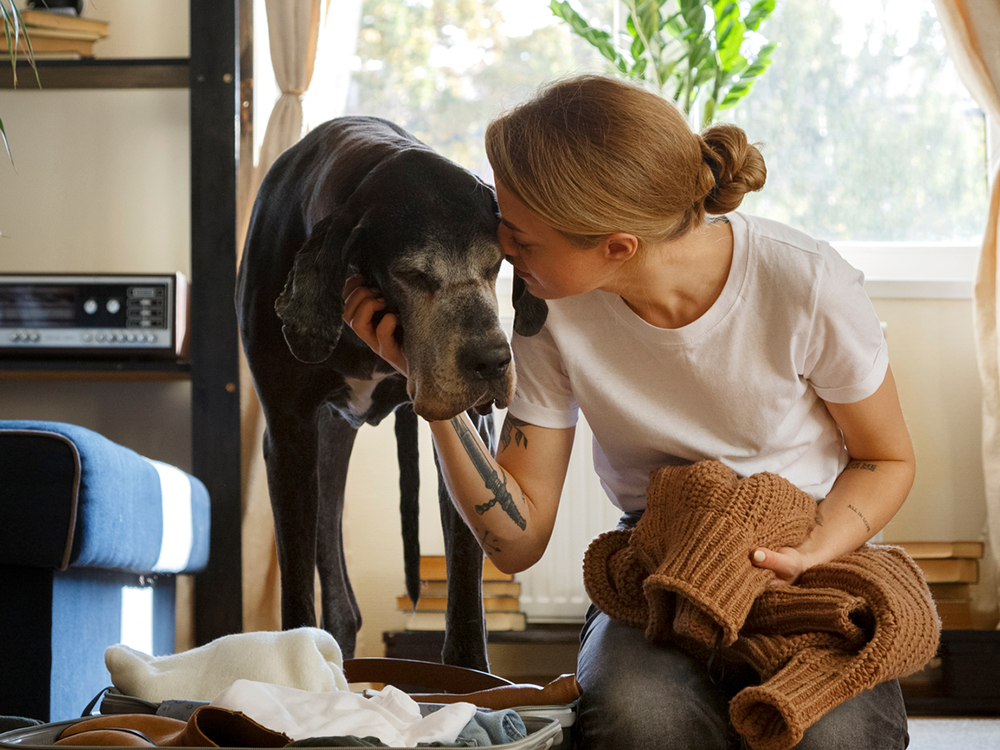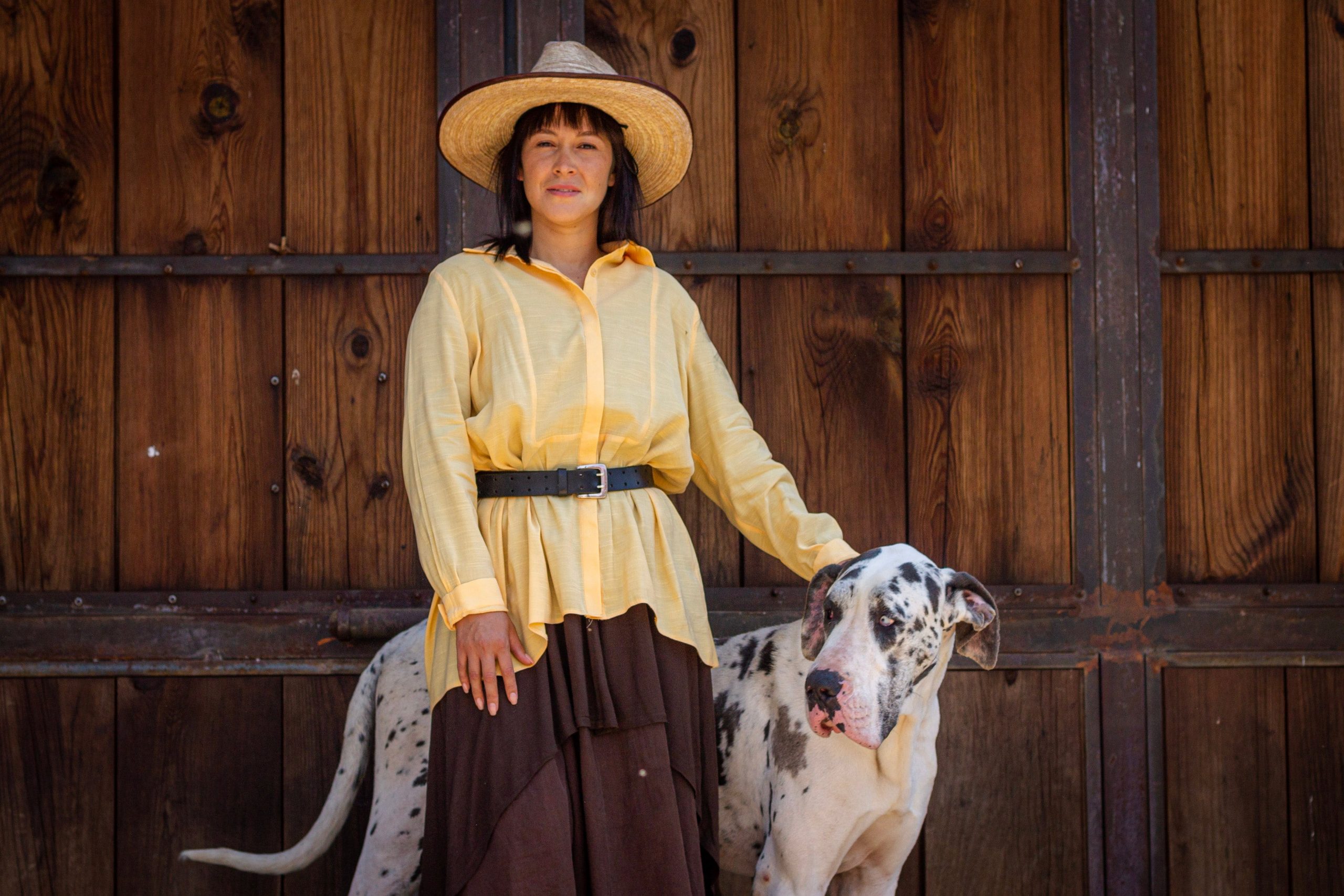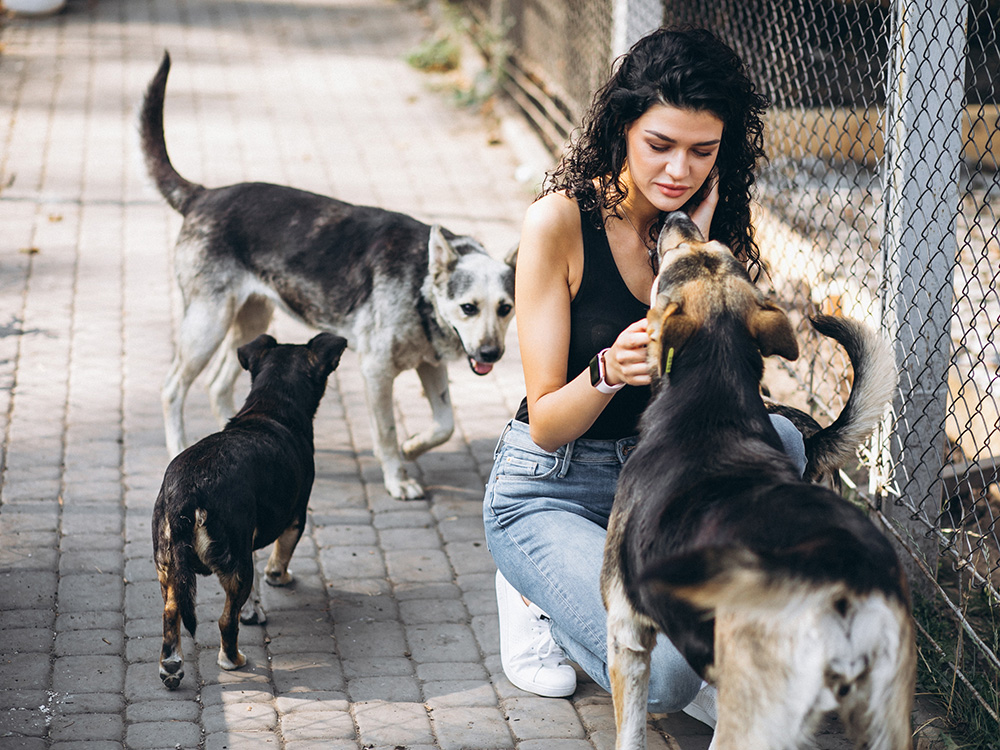By Alicia Kort
Danil Nevsky / Stocksy
Far too many apartment dwellers think they can’t have a dog just because they rent or live in relatively small spaces. While some landlords may have rules against pets, living in an apartment shouldn’t dissuade you from welcoming a dog into your life in and of itself. In reality, certain dog breeds thrive in smaller spaces, and we rounded up several dog breeds who do.
These breeds share some important qualities. Adaptability is one — renters often move more often than homeowners, so it’s best if their dogs are flexible to new situations.
Another important factor is exercise requirements. Dogs with very high exercise demands might struggle in an apartment, so we prioritized breeds with low to medium exercise requirements on this list. Often, apartments do not come with fenced-in backyards, and multiple trips to the dog park a day might not be feasible, so most of these dogs are satisfied with long walks, playtime, and maybe one trip to the dog park.
We also considered shed-level. Small spaces are more likely to be covered in multiple layers of fur if you live with a profusely shedding dog. Not every dog on this list is low-shed, but most shed moderately. If you’re considering adopting a dog, read on to see our list of apartment-friendly dog breeds. Not finding the breed you’re looking for? Check out these small dogs instead.
20 Apartment-Friendly Dog Breeds

Samson Katt / Pexels
1. Mixed-Breed Dog
Mixed-breed pups can make ideal apartment roommates. Ask a shelter or rescue about their current residents who are flexible to new environments and have low to moderate exercise needs. Those pups won’t just feel right at home in your apartment but will be thrilled to have a home of their own — no matter if it’s a studio or multiple bedrooms.

Przemyslaw Iciak / Adobe Stock
2. Beagle
The Beagle, who weighs up to 30 pounds and reaches up to 15 inches at shoulder height, can be a great roommate. These small dogs don’t take up much room, are highly adaptable, and shed a moderate amount (their double-coat sheds primarily in spring). These high-energy pups require an hour of exercise a day, but a long walk and a trip to the local dog park should satisfy them. Beagles are affectionate and love to be around people and other dogs, thanks to their history as pack-hunting dogs. These pups can grow destructive and howl if left alone for too long, though, so they are best for homebodies.

Jarusha Brown / Stocksy
3. Chihuahuas
Chihuahuas are another great apartment dog. These pint-sized pups love snuggling and will love watching your favorite shows with you, but they still need walks and some indoor play. Because Chihuahuas vary widely in coat color, length, and type (smooth or wiry), their fur care will depend on how long their fur is.

Irina84 / Adobe Stock
4. Cavalier King Charles Spaniel
The Cavalier King Charles Spaniel is a small breed — they can weigh up to 18 pounds and reach 13 inches at shoulder height. They adapt quickly to new surroundings, so they can handle frequent moves and shed moderately, which is great for apartment dwellers (although their coat needs to be brushed weekly and groomed regularly to avoid matting). They are affectionate and friendly toward other people, children, and other pets, although because they’re on the smaller and more delicate side, young children should be supervised when interacting with them.

Katya Wolf / Pexels
5. Maltese
The Maltese may have an ancient aristocratic history, but that doesn’t mean they aren’t down for small-space living. This easygoing pup quickly adjusts to new situations and surroundings, and their diminutive size (they only reach 9 inches at shoulder height and weigh around seven pounds) also makes them the perfect pick for a furry roommate. Maltese are highly affectionate, though they can be stubborn when it comes to training. This toy breed only requires daily walks or some indoor or outdoor play. The Maltese’s white fur coat is surprisingly low-shed (the Maltipoo (Maltese / Poodle mix) sheds even less), though it needs to be brushed daily to prevent matting.

Matt Amery / Shutterstock
6. Cockapoo
The Cockapoo, a mix between an American Cocker Spaniel and Poodle, can be either Mini or Maxi in size depending on their Poodle parent’s size, and weigh anywhere from 12 to 65 pounds and reach up to more than 16 inches at shoulder height, but both make good apartment companions. Flexible yet devoted, the Cockapoo is happy to go anywhere as long as they’re with their parents. They require less than half an hour of exercise per day, and their curly coat is low-shedding, which is perfect for small, high-traffic spaces, although it needs to be brushed frequently to keep it free of debris.

MART PRODUCTION / Pexels
7. Chiweenie
The Chiweenie is a mix between the Chihuahua and the Dachshund (also good apartment dogs), and the result is a tiny, devoted dog with a big personality. Chiweenies grow strongly attached to their pet parents and endeavor to be the center of attention. Weighing up to 12 pounds and reaching 10 inches at shoulder height, this pint-sized pooch is a great apartment pet and makes a loving companion for seniors and families with older children. Chiweenies love snuggling and will love watching your favorite shows with you, but they still need walks and some indoor play. Because Chiweenies vary widely in coat color, length, and type (smooth or wiry), their fur care will depend on how long their fur is.

Pearl Lynn / Pexels
8. German Spitz
The German Spitz is an adaptable pup that thrives in all types of environments, which makes them a great pet for small-space living. This breed comes in three different sizes, including Toy (weighing up to 11 pounds), Medium (weighing up to 25 pounds), and Large (weighing up to 50 pounds). The German Spitz is an eager-to-please breed with a profuse fluffy coat that sheds little except during the two shedding seasons, where the pup will shed their entire undercoat. They aren’t overly affectionate and like to do their own thing. This pup needs a medium amount of exercise — they love a long walk, so dog parents should be prepared to get their steps in — and mentally stimulating activities to keep them happy.

Gillian Vann / Stocksy
9. Rhodesian Ridgeback
The Rhodesian Ridgeback became famous in Africa for baying lions. These days they don’t tussle with apex predators, but they are known for being able to thrive in a variety of different living situations. The Rhodesian Ridgeback weigh up to 85 pounds and reach up to 27 inches in height, but living spaces on the smaller side don’t bother them. This breed needs a medium amount of exercise, including walks and playtime. They need to be socialized at an early age and trained with a firmer hand. Rhodesians have an independent streak and strong prey drive, so they should be kept on a leash while on walks or in a fenced space. This short-haired pup only needs to be brushed once a week to remove loose fur.

Siddharth shah /Unsplash
10. Saint Bernard
When you think of a Saint Bernard, you might think of a breed that navigates snowdrifts to rescue lost hikers, but this pup feels just as much at home in an apartment as they do in the Alps. Despite reaching up to 180 pounds and 30 inches at shoulder height, Saint Bernards only require moderate exercise. They like to spend time with their parents and go on hikes or long walks, but they don’t need to be “run out” like other large dog breeds. Saint Bernards are highly affectionate and get along well with young children or other pets, though they can be sensitive to harsh criticism. This breed can be short- or long-haired, but all have coats that shed heavily twice a year and need to be maintained by a weekly brushing session.

Iza Ponchie / Pexels
11. Basenji
An African hunting dog, the Basenji is an independent pup who spends a lot of time keeping their coats clean. This pup has high energy levels, so they are best suited to living with pet parents who have active lifestyles. The Basenji might be considered “barkless,” but they are not noiseless; they chortle and yip occasionally but make less noise than your average dog breed. They weigh up to 24 pounds and reach up to 17 inches in shoulder height. To care for the Basenji’s coat, just rub a hound glove over them once a week, and this pup will do the rest.

Daniel Kondrashin / Pexels
12. Pekingese
The Pekingese is famous for their lion’s mane of fur around their face and their proximity to China’s aristocracy. This royal lap dog is happy to continue in the tradition of living in the lap of luxury. They bond closely with their parents and only require daily walks and the occasional play session, making them ideal apartment pups and companions to seniors. Pekingese only weigh up to 14 pounds and reach up to 9 inches at shoulder height, so they are not the best choice for parents with young children because they’re delicate. Although their exercise needs are low, the Pekingese’s grooming needs are not: Their thick double coat will require one hour per week plus regular baths.

Danil Nevsky / Stocksy
13. Great Dane
Great Danes may stand taller than their dog parents when they’re on their hind legs, but that doesn’t mean they aren’t happy in apartments. These large pups can weigh up to 175 pounds and reach up to 32 inches in height, and have moderate exercise needs; they need a substantial walk several times a day — otherwise, they’re happy to take up your entire couch while they lounge. This breed is incredibly devoted and prefers to spend time with their families than alone. Although their coat is on the short side, it still needs weekly brushing as they can accumulate more fur than most pet parents would guess.

ksuksa / Adobe Stock
14. Shiba Inu
The Shiba Inu is a compact, muscular hunting dog who is the most popular pup in Japan. They can weigh up to 23 pounds and reach 17 inches in shoulder height. This fox-like dog is considered adaptable and is more than happy living in an apartment, though they need to get enough exercise to fulfill their moderate needs, which can be accomplished with a long walk and a trip to the dog park. They are very loyal companions, so much so that they can suffer from separation anxiety and grow destructive. This breed should be crate-trained early to learn to be comfortable while their parents are out of the house.

Marek Perička / Pexels
15. Basset Hound
The Basset Hound’s chill personality perfectly complements their sweet appearance and droopy face. These people-oriented pups are more than happy to lie next to you on the couch during movie marathons or a reading session so long as you give them a couple of good walks.

Guille Faingold / Stocksy
16. Labrador Retriever
One of the most popular dogs in America, this medium-to-large athletic pup weighs up to 80 pounds. But despite their size, Labrador Retrievers make great apartment dogs when given the physical and mental exercise that they need.

RDNE Stock project / Pexels
17. American Cocker Spaniel
The American Cocker Spaniel is a beautiful small-sized dog with an affectionate nature, long soft ears, and an adorable face. These dogs need mental stimulation to keep from getting bored, but moderate exercise is generally sufficient. And their eager-to-please attitude makes them a breeze to train.

Eva / AdobeStock
18. American Pit Bull Terrier
Similar to other medium to large breed dogs on this list, American Pit Bull Terriers can be excellent apartment dogs as long as they receive adequate exercise and mental stimulation. Due to their high energy level, Pit Bulls require regular walks, jogging sessions, or playtime to release their excess energy. These pups are known as “Velcro Dogs” because they form strong bonds with their families.

Leeloo Thefirst / Pexels
19. Whippet
Despite their speed, Whippets also love lounging and relaxing (as long as they’ve had a daily walk or chance to run freely and fulfill their exercise needs). They have gentle temperaments and make wonderful companions. They have a strong prey drive but are very amiable and open to training.

Evelyn / Pexels
20. Shar-Pei
Another great apartment dog is the Shar-Pei. These pups love their people but be sure to provide them with regular mental stimulation to prevent boredom. Shar-Peis weigh up to 60 pounds and are generally a healthy breed, but be aware of potential skin problems, including allergies and infections due to their wrinkles. Proper grooming includes regular cleaning and drying of the skin folds. Get in there.
Tips for Renting with Dogs
Parents give away their pets all too often when they move because of a landlord’s restrictions, so before you get a dog, it’s important to make sure you’re prepared to take extra steps to find a pet-friendly living arrangement. Search specifically for dog-friendly rental units so you know that your landlord is open-minded to having people with pets apply. You can even make a resume for your pet (seriously!) with references from previous landlords. And be sure to check with your landlord about potential size and breed restrictions before you adopt a dog. It’s important to keep you, your landlord, and, most importantly, your pet happy in your rented space.
Insurance
Pet parents should get renters’ insurance, which is also a smart idea even if you don’t have a pet. Renters’ insurance covers a lot of different situations, including break-ins, natural disasters, and pet damages. If your pup chews up the carpet or jumps up on a neighbor in the hallway and accidentally injures them, your insurance might cover that. This all depends on your policy, of course, so make sure to read through your insurance policy thoroughly.
Training
A well-trained pup will make living in a rented space much easier for everyone involved. A dog who knows their boundaries will be more likely to stay within them. Different breeds require different types of training, and a trainer can help you navigate your dog’s needs.
Exercise
All pups require some level of exercise, even if it is just a walk along the block. Before you get your pup, research their breed or get information from the shelter about their exercise needs. If your dog does not get enough exercise, they can grow destructive while you’re not in the apartment, which could involve barking or damaging furniture.
Breeds to Avoid
Be thoughtful about the dog you choose — any moderate to high-energy working breed should be avoided unless you live a very active lifestyle. Dogs who don’t thrive in apartments include breeds such as Belgian Malinois, German Shepherds, and Border Collies. These breeds are used to having jobs and need a lot of mental and physical stimulation that they are unlikely to get in a rented space.
Some parents might also want to avoid breeds that shed heavily because an apartment is likely a smaller space than a house, so more of that space will be covered in a layer of fur. German Shepherds are another culprit in that area, along with Huskies and Great Pyrenees.
Alicia Kort is a writer and editor living in Brooklyn. She’s currently the senior commerce editor at Apartment Therapy. She’s been published in StyleCaster, Electric Literature, Newsweek, Interview, Brooklyn magazine and more. In her free time, she runs, reads, and spends time with her dog-nieces, Maya and Lady, and her cat-niece, Pepper.



